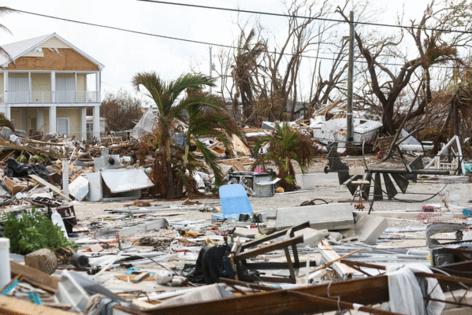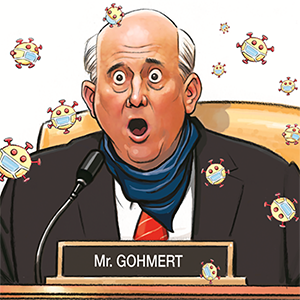Florida insurance companies steered money to investors while claiming losses, study says
Published in News & Features
TALLAHASSEE, Fla. — While Florida insurers claimed to be losing money in the wake of hurricanes Irma and Michael, their parent companies and affiliates were making billions of dollars, according to a study obtained by the Times/Herald.
The start of the state’s insurance market meltdown came on the heels of those two storms between 2017 and 2019, as companies justified big rate increases to cover their losses.
But those financial hardships don’t tell the full story, according to the 2022 study that has never been made public and was released to the Times/Herald after a two-year wait for public records.
The report, the most in-depth dive into the byzantine finances of Florida’s homeowners insurance market, reveals that as the industry was ailing and companies were losing money, executives distributed $680 million in dividends to shareholders while diverting billions more to affiliate companies.
Executives with most Florida-based insurers were removing so much money from their companies that they violated state regulations, the study’s author concluded.
The result left some insurers financially weaker — and potentially unable to pay claims — heading into the depths of the state’s insurance crisis.
State lawmakers never saw the report.
The state’s then-insurance commissioner and Gov. Ron DeSantis focused on legal reforms making it harder to sue insurers.
And regulators have not repeated the study since, despite a recommendation from the report’s author.
The findings are a “smoking gun” that confirms what has long been suspected in Florida’s market, said Doug Quinn, executive director of the watchdog American Policyholder Association.
“These companies are crying poverty in order to raise premiums or justify insolvency: ‘It’s litigation, it’s fraud,‘” Quinn said. “This is money shifting from their left pocket to the right, and crying poverty while their right pocket bulges.”
State regulators say the insurance market is different today. In recent years, Florida Insurance Commissioner Mike Yaworsky has pushed for more oversight of affiliate companies. This year, he’s asking lawmakers to change how insurers pay affiliates.
While the report is an incomplete picture of insurers' money, Florida’s Office of Insurance Regulation said in a statement, the study affirms that the reforms the office wants are warranted.
But Paul Handerhan, founder of the trade group Federal Association for Insurance Reform, whose members include insurance companies, disputed the idea that executives were deliberately moving money around.
“This notion that they’re fleecing their policyholders and offshoring the money to their affiliates is just not happening,” Handerhan said. “None of these guys did this as a strategy.”
During debates in the Legislature over how best to respond to the insurance crisis between 2018 and 2023, some lawmakers asked what role affiliate companies played.
Rep. Hillary Cassel, R-Dania Beach, said lawmakers and observers had a lack of data about affiliates, known in the industry as “managing general agents,” when they were voting on legislation.
“All of us informed on the issues knew (managing general agents) were a problem,” said Cassel, a former lawyer for insurance companies who now sues them.
The Office of Insurance Regulation said in a statement that the study was not given to lawmakers because it was “not a formal examination report.” It was produced months before lawmakers met in emergency legislative sessions in 2022 and left in a “draft” status.
“Our office does not release every internal analysis of companies to the Legislature,” the office said.
The Times/Herald requested the report in November 2022, but the office did not turn over the executive summary until December 2024.
The affiliate structure is nothing new in Florida.
Profits of insurance companies are limited by regulators to about 4.5% — hardly enticing to investors, considering the risk of hurricanes.
However, insurance executives in Florida have used financial workarounds to reward investors and themselves.
While the profits and executive compensation of the insurance company are capped, the profits of affiliate and parent companies are not.
So executives create sister companies that charge the insurance company for basic services, such as claims handling, underwriting, accounting and issuing policies. (Large national insurers typically handle all of those services internally.)
Arrangements between insurance companies and affiliates must be approved by the state, and regulations say they must be “fair and reasonable,” which isn’t defined in state law.
Company structures can appear like a spiderweb of entities. When FedNat Insurance went insolvent in 2022, it was one of nine corporations under a parent company.
When Southern Fidelity Insurance dissolved that year, it was one of six companies under the same umbrella, and its holdings included a hunting lodge maintained at a cost of $485,000 per year. State officials were investigating whether the company “took active measures to conceal these costs” from regulators, according to an October insolvency report.
Most insurers in Florida have similar arrangements, which are enormously lucrative for some executives who were the highest-paid in the nation in some years.
But this type of setup can be easily abused and requires greater regulatory scrutiny, according to the National Association of Insurance Commissioners.
That’s because the owner of the insurance company also owns the affiliates, creating an incentive for executives to overcharge the insurance company for services.
Such abuses have been repeatedly found by state officials as the reason why companies go insolvent. In one 2009 insolvency, auditors wrote that executives were “stripping the company of cash” as it was going out of business. The ratings agency AM Best last year found that affiliate relationships were the third-leading cause of insolvencies nationwide between 2000 and 2022, after catastrophe losses and fraud, Insurance Journal reported.
Still, it’s unlikely Florida regulators knew the full scope of insurance money-shifting arrangements until 2021, when lawmakers gave them the ability to demand more information from insurers and affiliates.
Using that power, the state’s then-commissioner, David Altmaier, paid a Connecticut-based consultant nearly $150,000 to parse through the information the companies provided. Several companies turned over incomplete data, according to the study.
Between 2017 and 2019, the insurers in the study (minus a couple of outliers) showed a net loss of $432 million.
Their affiliate companies showed a net income of $1.8 billion.
With all 53 companies included, the industry recorded $61 million in net income, and affiliates made about $14 billion in net income, according to the study. Those figures likely include national carriers that also provide auto insurance.
The author noted that the affiliates of Florida-based companies were profitable even after they injected $485 million back into the insurers and waived $208 million in fees during the three years, steps made to help keep the insurers afloat.
In the author’s opinion, 19 of the 30 Florida-based companies that provided data were paying fees to their affiliate companies that were “not fair and reasonable.”
The numbers in the study are “eye-popping” and raise questions about why regulators would allow such financial arrangements, said Birny Birnbaum, executive director of the Center for Economic Justice and a former chief economist at the Texas Department of Insurance.
“It’s unclear why (the Office of Insurance Regulation) isn’t doing anything about it,” Birnbaum said.
Regulators this year are asking lawmakers to define “fair and reasonable” to include the actual cost of the service provided, the overall health of the insurer and how much in dividends were paid out. Regulators asked for that in 2023 but lawmakers rejected it, claiming it would “upset the apple cart” of Florida’s insurance industry.
The office’s proposed legislation would also require fees to affiliates be paid in dollar amounts, instead of percentages. Affiliates will typically charge the insurance company fees of between 20% and 34% of premiums, which results in more money for the affiliates when premiums go up.
The office has canceled or modified some companies’ agreements. In 2023, for example, one company’s contract with an affiliate was canceled after regulators discovered that the affiliate was charging the insurer additional fees on top of the cost of the services being provided, according to the office.
_______
©2025 Tampa Bay Times. Visit tampabay.com. Distributed by Tribune Content Agency, LLC.







Comments